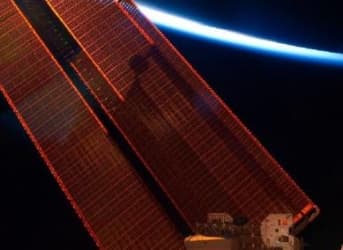Has space-based solar power just had a breakthrough moment?
Alternative Energy News reports that on March 12th, 2015 Mitsubishi Heavy Industries, Ltd. (MHI) successfully conducted a ground demonstration test of “wireless power transmission.” In the test, MHI successfully transmitted 10 KW of electricity via microwave to a receiver 500 meters away. This test also confirmed that advanced control technology could direct the microwave beam to stay on target. Will this success pique other countries’ interest?
Japan plans 1GW Space Solar Plant by 2030
Japan, China, India, Europe and the U.S. have research programs to harvest solar energy from space. Following the Fukushima Daiichi nuclear plant accident, Japan conducted a review of all its available energy options. In 2014, the Japanese Aerospace Exploration Agency (JAXA), considered the global leader of space-based solar systems, presented a 25-year development roadmap of ground and orbital demonstrations that culminates in the 2030s with a 1GW commercial system. This output is similar to typical nuclear power plant. Related: New Silk Road Could Open Up Massive Investment Opportunities
How Does It Work?
In a space-based solar system, reflectors launched and positioned in orbit, unfurl and direct solar radiation onto solar panels. The energy is converted either into a laser or microwave beam and transmitted to receiving stations on earth that collect the beam and convert it to electricity and feed into electric grids.
Microwave space-based systems are large and launched deep into space, while smaller laser systems operate in lower earth orbit. Microwaves work in all weather, giving them an advantage over lasers that are absorbed and scattered by water molecules in clouds. An orbital solar system that only works on clear days isn’t very useful; therefore, most major research programs are focused on microwave systems; though the laser approach has its champions.
A 1GW microwave orbital solar system would be massive. Estimates indicate 10,000 metric tons and three American football fields across. There are many challenges to solve, including: “wireless power transmission, space transportation, construction of large structures in orbit, satellite attitude and orbit control, power generation, and power management.”
According to the IEEE, wireless power transmission, where JAXA is focused, is the most daunting challenge to solve. NASA is working on very efficient, and very aesthetically pleasing flower-shaped, solar collectors that will beam microwaves to earth. NASA proposes to develop its Solar Power Satellite via Arbitrarily Large Phased Array (SPS-ALPHA) through four generations of prototypes with final launch in 2025.

It’s Expensive
None of this will be cheap. The first space based solar system could top $20 billion. Each launch, as it is built, could cost as much as $40,000.
A Strategic Advantage for U.S. National Security
The U.S. Naval Research Laboratory (NRL) is focused on reducing the power cost per pound launched into space. Dr. Jaffe, a leading NRL researcher, is focused on a “sandwich” module prototype - a single unit that receives solar energy on one side, converts it to electricity using electronics in the middle and transmits to earth via an antenna on the other side that is lighter than other options. NRL also has one of the only test environments that simulates space. In the post 9/11 world, the U.S. Department of Defense National Security Space Office sees space based solar as an important element for national security. Futurist George Friedman, in his book The Next 100 years, forecasts space-based solar systems will be a key strategic advantage for the U.S. Related: The Front-Runners In Fusion Energy
Space Spin-offs to counter Skeptics
Skeptics might scoff that all this is a waste of money that would be better spent on earth. But big science that pushes the envelope can have big payoffs in the long-term. NASA catalogs spinoffs that bring “technology down to earth,” e.g. telescope technology that has improved eye surgery and detectors that improve safety of aircraft wiring.
We can thank NASA for memory foam and advancements in many industrial and socio-economic categories including environmental protection, agriculture, medicine, transportation, and computer science. You can bet Mitsubishi will look for other uses for its newly built competence in microwave transmission and control technologies.
Other private sector firms (e.g. the established firms like Boeing , Ariannespace, Lockheed Martin and newcomers like SpaceX), that design and launch satellites and those involved in building large space projects such as the International Space Station could be involved in proving and building any space-based solar system. Related: Electric Vehicles To Become Mainstream In Short Period Of Time
Big Thinkers drive Big Science. Is the race now on?
The scale and complexity of feats accomplished in space have always attracted big thinkers. Former astronauts and engineers, convinced that harvesting solar energy from space is closer than ever, have set up shop (e.g. Artemis Innovation Management Solutions) to pursue the dream.
The California firm, Solaren, has been the most ambitious. In 2009, Solaren agreed a contract with Pacific Gas and Electric to deliver 200MW of space harvested solar power by 2016. The California Public Utilities Commission unanimously approved the power purchase agreement with the proviso that solar power from space doesn’t count towards PG&E’s quota for reaching CA renewable mandate until Solaren reaches certain milestones.
Questions to Solaren seeking comment on MHI’s successful microwave test or progress towards their 2016 goal went unanswered. Stay tuned. With government, private sector and military searching for big energy options beyond fossil fuels and nuclear power, a race for solar power from space might just be getting started.
By Ronke Luke for Oilprice.com
More Top Reads From Oilprice.com:
- Global Oil Shortage Before Year’s End? Surely Not…
- Bursting The Solar Leasing Bubble
- A Bit Of Perspective On Gasoline Prices


















